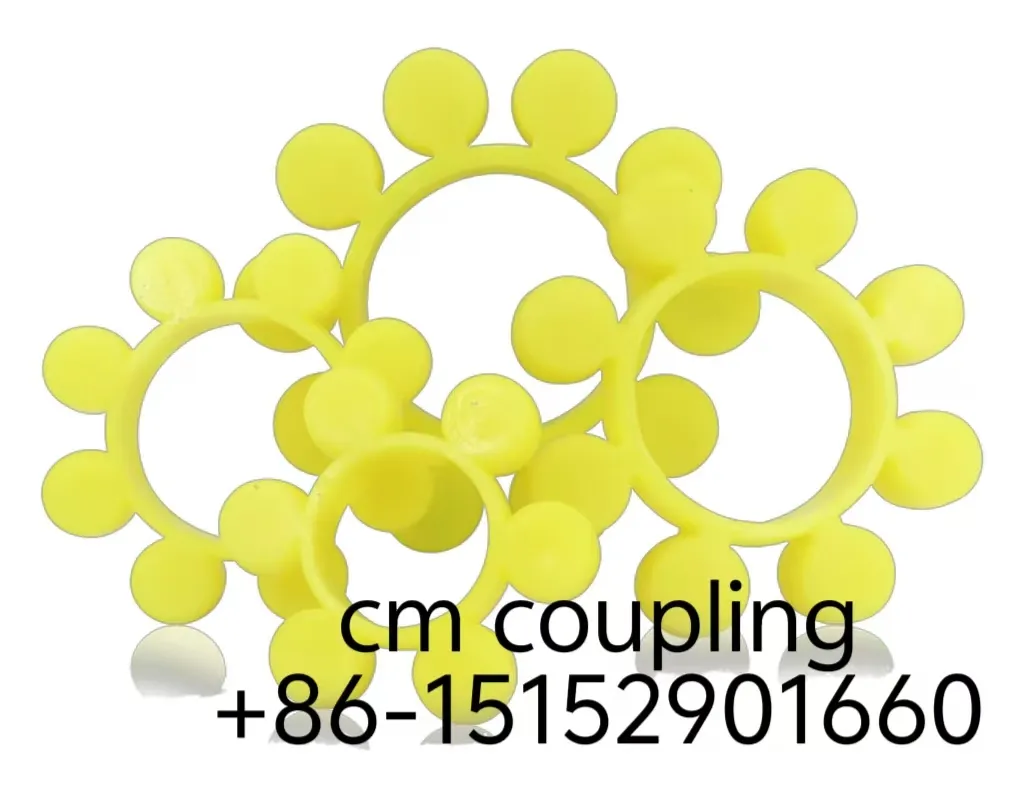Copyright © 2025 Chuangming Coupling (Jiangsu) Co.,Ltd.
Flexible spider: A key component for ensuring the stability of the shaft system transmission
2025-09-26
In the field of mechanical transmission, the coupling serves as the core component that connects different shaft systems of various mechanisms,and is responsible for transmitting torque and compensating for offsets. flexible spider with its unique structure and performance, becomes a crucial component for achieving efficient and stable transmission in the coupling.
flexible spider is usually made of elastic materials such as polyurethane and rubber, presenting a structure resembling a flower petal. This ingenious design features multiple elastic petals distributed around the central ring-shaped area,enabling it to play multiple important roles during operation.
From the perspective of torque transmission,the flexible spider achieves smooth torque transmission by interlocking with the claw-shaped structure of the coupling. When the driving shaft rotates, the torque is transmitted through the elastic petals of the elastic pad to the driven shaft. The characteristics of the elastic material can effectively buffer the impact loads during the transmission process,preventing rigid impacts from causing damage to the shaft system and related equipment,especially suitable for transmission systems with frequent starting and braking conditions,significantly improving the transmission stability.
In terms of compensating for shaft system offsets,the flexible spider demonstrates outstanding capabilities. Due to manufacturing and installation errors as well as vibration, thermal deformation, and other factors during the operation of the equipment, the connected shaft systems often have various forms of offsets,such as axial,radial,and angular. The elastic deformation characteristics of the flexible spider can compensate for these offsets within a certain range,ensuring that the coupling is always in a good transmission state and preventing the generation of additional stress due to shaft system offsets, thereby extending the service life of the shaft system components.

In addition,the flexible spider has excellent vibration and noise reduction performance. During mechanical transmission,vibration and noise are inevitable. The elastic material of the flexible spider can absorb some of the vibration energy,reduce the transmission of vibration, and minimize the noise generated by impact and friction,creating a quieter and more stable environment for equipment operation. This is crucial for precision machinery and industrial equipment with high requirements for working environments.
In the field of mechanical transmission, the coupling serves as the core component that connects different shaft systems of various mechanisms,and is responsible for transmitting torque and compensating for offsets. flexible spider with its unique structure and performance, becomes a crucial component for achieving efficient and stable transmission in the coupling.
flexible spider is usually made of elastic materials such as polyurethane and rubber, presenting a structure resembling a flower petal. This ingenious design features multiple elastic petals distributed around the central ring-shaped area,enabling it to play multiple important roles during operation.
From the perspective of torque transmission,the flexible spider achieves smooth torque transmission by interlocking with the claw-shaped structure of the coupling. When the driving shaft rotates, the torque is transmitted through the elastic petals of the elastic pad to the driven shaft. The characteristics of the elastic material can effectively buffer the impact loads during the transmission process,preventing rigid impacts from causing damage to the shaft system and related equipment,especially suitable for transmission systems with frequent starting and braking conditions,significantly improving the transmission stability.
In terms of compensating for shaft system offsets,the flexible spider demonstrates outstanding capabilities. Due to manufacturing and installation errors as well as vibration, thermal deformation, and other factors during the operation of the equipment, the connected shaft systems often have various forms of offsets,such as axial,radial,and angular. The elastic deformation characteristics of the flexible spider can compensate for these offsets within a certain range,ensuring that the coupling is always in a good transmission state and preventing the generation of additional stress due to shaft system offsets, thereby extending the service life of the shaft system components.

In addition,the flexible spider has excellent vibration and noise reduction performance. During mechanical transmission,vibration and noise are inevitable. The elastic material of the flexible spider can absorb some of the vibration energy,reduce the transmission of vibration, and minimize the noise generated by impact and friction,creating a quieter and more stable environment for equipment operation. This is crucial for precision machinery and industrial equipment with high requirements for working environments.